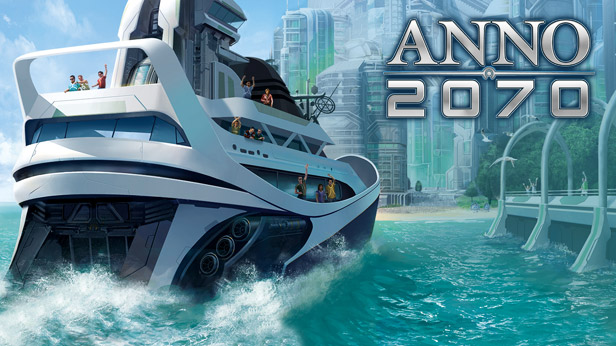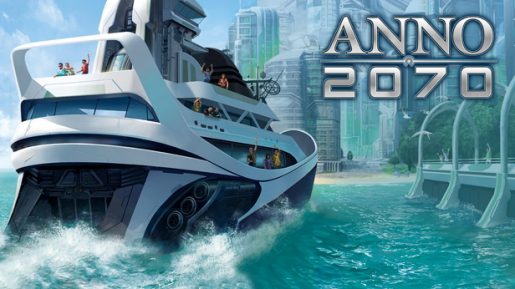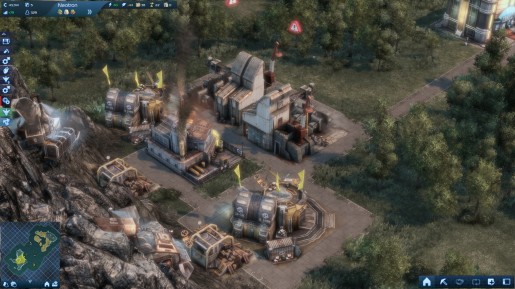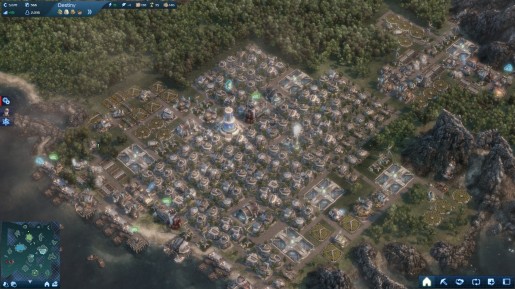Anno 2070 is the latest game in the award winning city building and real time strategy series that is for the first time ever set in the near future. Set in 2070 the Earth is a rather different place with world flooding, architectural breakthroughs and new challenges. Will the change in era and new gameplay mechanics make or break the series?
Let’s find out and kick off the HOTs and NOTs.
HOTs
Presentation
With Anno 2070 the series has changed from past to future and it seems the graphics have also managed to make an incredible leap too. There’s a stunning difference between the vibrant Eco city buildings and the dismal begrimed factories the Tycoons use. At the same time every single building has been intricately designed. Players can use a range of viewpoints to peer upon their city and this is when the little details come into play – making the world feel alive. From the astonishingly natural islands and crashing waves on the beaches to the birds that fly across the sky; everything adds to the immersive environment.
The presentation isn’t only phenomenal due to the visuals through. The background music is chilling and mellow when everything is peaceful but when actions of violence occur it soon starts to add a slight air of tension to the game until the threat has passed. The cities also have sounds which make them more realistic. An excellent example of this is the heavy metallic clunky sounds from the factories. All in all the game looks and sounds amazing, the team has done an outstanding job of making a truly lifelike and believable game world.
Animations
Anno 2070 has a pleasant presentation and this is only improved by the levels of animations players can see around their living, breathing city. Hovering vehicles fly around the city, transporting materials and goods around your province, Rotary blades on the turbines slowly turning in the wind and even the individual people wandering around the town and standing on the roofs of the apartments; the game is full of lifelike animations which go hand in hand with the presentation to make the place feel alive.
Campaigns
The story mode is split into 3 campaigns each offering multiple components in the form of missions. The first couple of missions step players through the basics of the games. New players to the series will be able to use this as a simple tutorial that teaches them the different buildings and stages of city construction. Veterans of the series will be able to use this to learn the changes and additions to the series and also as a refresher course as everything is now futuristic.
While there aren’t too many missions they will all take time to complete meaning the game does offer an adequate amount of storyline content. The time spent in the missions will mostly be going through various tasks, bringing in new concepts as well as combining previously seen objectives. One nice touch is that for the campaigns the city you build up is kept onto the next mission so it feels like you are truly developing the city and the island. While the campaigns do offer a decent amount of content and are fun to play the continuous mode is almost certainly where most players will spend hours and hours of game time.
Continuous Games
The continuous game mode is full of opportunities to customise the overall experience enabling the player to choose an assortment of settings about the starting conditions, winning conditions and even the game world itself. The starting conditions are pretty standard when it comes to real time strategy games; allowing the player to pick how many credits, warehouses and ships they have as well as being able to set how long there is forced peace from the start of the game. Winning conditions can range from the number of inhabitants or military points all the way to wealth and accumulated mission points. The Game World settings are where the settings get a bit more interesting. It permits players to set the likelihood of city disasters and even natural disasters.
After the game starts players are not completely thrown to the wolves. E.V.E. the helpful AI is still there at hand to give occasional hints and other faction leaders will offer missions with rewards that also build your influence with their faction. The gameplay might be slower than other real time strategy games, as the objective isn’t focused on military as much as a sustainable city, but this is a refreshing change.
The continuous game mode also offers players a decent challenge in the form of three obvious difficulties. Easy is created for beginners and it would be wise for most new players including those who often play games from the real time strategy genre to try the game out for the first time on this mode. Normal mode offers generally larger maps than easy mode and will present a challenge to most gamers. Difficult is definitely an understatement as the mode is almost impossible. I don’t class myself as a veteran player to the series or genre but I have played the series and genre for too many hours and still Difficult is incredibly hard. That being said it offers such a challenge players will be happy to work up the ranks and learn the game inside out to be able to finally win on Difficult.
Variety of buildings
Anno 2070 offers a wide range of distinctive buildings which all have unique purposes. From simple warehouses and harbours to munitions factories and health food factories the game has a building for the needs of your people. There are also buildings exclusively for one faction. For Eco they can use weather control stations to improve their carbon footprint, theatres to entertain the population and wind turbines to produce power. Tycoons however can’t use these buildings but have access to different buildings including casinos; their version of an entertainment building.
Simple Interface
The simplistic design o the HUD means the majority of the screen is left to what players want to see the game itself. A large proportion of games that leave the screen relatively clean and clear forget the entire meaning of a HUD but not Anno 2070. It fits all the information that players will need and find helpful onto the screen; including messages about updates to your production lines, a mini map and statistics or information about the building you have selected. This makes Anno 2070 extremely easy to play as everything you need to know is there, whilst not over crowding the screen.
NOTs
Slow Pace
Personally I found the slower pace that focused a lot more on sustainability of you faction rather than military power a fresh change but not all will like this difference. While it is possible to quickly gain military units to start attacking enemies the game doesn’t make this the focal point especially in the first couple of hours of a continuous game. Fans of the series will know and love the format but new players may dislike the game speed in the early hours of a map.
Verdict
 Anno 2070 is somewhat of a surprising real time strategy treasure. Often after making such a dramatic change to a series the gameplay and the themes suffer but this isn’t the case for Anno 2070. The factions have distinctive differences in not only appearance but also to some extent in the gameplay. Offering incredible presentation, compelling gameplay and plenty of content the game will surely be enjoyed by many for years to come. The only issue that some may have is the pace of the game but for anyone looking for something different you can’t go wrong with Anno 2070.
Anno 2070 is somewhat of a surprising real time strategy treasure. Often after making such a dramatic change to a series the gameplay and the themes suffer but this isn’t the case for Anno 2070. The factions have distinctive differences in not only appearance but also to some extent in the gameplay. Offering incredible presentation, compelling gameplay and plenty of content the game will surely be enjoyed by many for years to come. The only issue that some may have is the pace of the game but for anyone looking for something different you can’t go wrong with Anno 2070.
[Editor’s Note: Anno 2070 was reviewed on the PC. The game was provided to us by the publisher for review purposes.]




